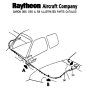Superpilot61
Filing Flight Plan
CFI checkride today! yes i finished it and yes i passed! but a BIIGG lesson learned. always check the aircrafts inspections. and read the whole paragraphs dont just look for the word "annual" and the tach time.
here is the story:
Met my check airman at the FW FSDO this morning and we started going over the log books for the aircraft. I show him the 100 hour for the engine and he starts to read over it... he points out to me that cylinder #3 has a compression ratio of 40/80!!!! wow he must of actualy read it all! somethign i should of done... long story short he brings a few of his closst faa freinds and they thumb through my aircrafts logs... ( maybe the worst feeling in the world) they decide among themselves that the airplane is unairworthy. they said for this aircraft it must be at least 60/80 comp. ratio.. IS THIS TRUE?? they take my engine logs and tell me to call a mechanic to take a look at it and get a ferry permit issued. in other words CHECKRIDE IS OVER! i call my mechanic who did the work and turns out to be a typo in the log. they fax up the good number (70/80) and we are good to go... wow what an experiance...
Lesson learned and i will definetly pass this lesson on to students....
(sorry for MY typos here i have allready had a few "celabratory" beers)
Also anythoughts on the requirments of the comp. ratios?!?!
here is the story:
Met my check airman at the FW FSDO this morning and we started going over the log books for the aircraft. I show him the 100 hour for the engine and he starts to read over it... he points out to me that cylinder #3 has a compression ratio of 40/80!!!! wow he must of actualy read it all! somethign i should of done... long story short he brings a few of his closst faa freinds and they thumb through my aircrafts logs... ( maybe the worst feeling in the world) they decide among themselves that the airplane is unairworthy. they said for this aircraft it must be at least 60/80 comp. ratio.. IS THIS TRUE?? they take my engine logs and tell me to call a mechanic to take a look at it and get a ferry permit issued. in other words CHECKRIDE IS OVER! i call my mechanic who did the work and turns out to be a typo in the log. they fax up the good number (70/80) and we are good to go... wow what an experiance...
Lesson learned and i will definetly pass this lesson on to students....
(sorry for MY typos here i have allready had a few "celabratory" beers)
Also anythoughts on the requirments of the comp. ratios?!?!



